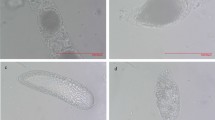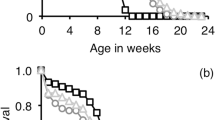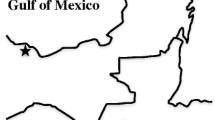Abstract
The effects of reproduction are variable among insects, as well as the time of mate. In animals, a trade-off is usually observed between reproduction and self-maintenance, mostly in females because of egg producing costs. In the present investigation, manifestations of aging and senescence at population and cellular levels were studied associated with the mating opportunities. The main goal of this study was to evaluate the effect of mating on lifespan and also on the physiological aging in adult Jamaican field cricket females, Gryllus assimilis (Fabricius, 1775). Three experimental groups were set: virgin, normal-mated (14 days old), and late-mated (30 days old) insects. Lifespan, age-specific mortality rate, number of eggs laid, and in situ amount of the age-pigment neurolipofuscin were quantified. Results showed a trade-off between reproductive females and lifespan, with the strongest effects found in late-mated. Age-specific mortality showed a faster increase for late-mated females from 35 to 50 days old, followed by normal-mated females (35 to 60 days old). Virgins had the lowest age-specific mortality of all, increasing just from 65 to 73 days old. Normal-mated had the highest number of eggs laid, followed by late-mated and virgins, respectively. Neurolipofuscin accumulation rate was similar among groups, which was reflected in similar physiological rate of aging. Results indicate that reproductive status did affect the life-history of these field cricket females.




Similar content being viewed by others
References
Bentur JS, Dakshayani K, Mathad SB (1977) Mating induced oviposition and egg production in the crickets, Gryllus bimaculatus De Geer and Plebeiogryllus guttiventris Walker. Z Angew Entomol 84:129–135. https://doi.org/10.1111/j.1439-0418.1977.tb04272.x
Boulianne G (2001) Neuronal regulation of lifespan: clues from flies and worms. Mech Ageing Dev 122(9):883–894. https://doi.org/10.1016/S0047-6374(01)00245-7
Carey JR (2001) Insect biodemography. Annu Rev Entomol 46(1):79–110. https://doi.org/10.1146/annurev.ento.46.1.79
Carey JR, Liedo P (1999) Mortality dynamics of insects: general principles derived from aging research on the Mediterranean fruit fly (Diptera: Tephritidae). Am Entomol 45(1):49–55. https://doi.org/10.1093/ae/45.1.49
Carey JR, Liedo P, Orozco D, Vaupel JW (1992) Slowing of mortality rates at older ages in large medfly cohorts. Science 258(5081):457–461. https://doi.org/10.1126/science.1411540
De Loof A (2011) Longevity and aging in insects: is reproduction costly; cheap; beneficial or irrelevant? A critical evaluation of the “trade-off” concept. J Insect Physiol 57(1):1–11. https://doi.org/10.1016/j.jinsphys.2010.08.018
Dean JM (1981) The relationship between lifespan and reproduction in the grasshopper Melanoplus. Oecologia 48(3):385–388. https://doi.org/10.1007/BF00346499
Drenos F, Kirkwood TB (2005) Modelling the disposable soma theory of ageing. Mech Ageing Dev 126(1):99–103. https://doi.org/10.1016/j.mad.2004.09.026
Fahrenholz L, Lamprecht I, Schricker B (1992) Calorimetric investigations of different castes of honey bees, Apis mellifera carnica. J Comp Physiol B 162:119–130. https://doi.org/10.1007/BF00398337
Fedorka KM, Zuk M, Mousseau TA (2004) Immune suppression and the cost of reproduction in the ground cricket, Allonemobius socius. Evol 58(11):2478–2485. https://doi.org/10.1111/j.0014-3820.2004.tb00877.x
Finch CE (1990) Longevity, senescence and the genome. University of Chicago Press, Chicago
Flatt T (2011) Survival costs of reproduction in Drosophila. Exp Gerontol 46(5):369–375. https://doi.org/10.1016/j.exger.2010.10.008
Fonseca DB, Brancato CL, Prior AE, Shelton PM, Sheehy MRJ (2005) Death rates reflect accumulating brain damage in arthropods. P Roy Soc B-Biol Sci 272:1941–1948. https://doi.org/10.1098/rspb.2005.3192
Froy H, Lewis S, Nussey DH, Wood AG, Phillips RA (2017) Contrasting drivers of reproductive ageing in albatrosses. J Anim Ecol 86(5):1022–1032. https://doi.org/10.1111/1365-2656.12712
Gershman SN (2008) Diet quality mediates the effect of multiple mating on female Gryllus vocalis vocal field cricket lifetime reproductive success. Evol Ecol Res 10(2):269–280
Gershman SN (2009) Large numbers of matings give female field crickets a direct benefit but not a genetic benefit. J Insect Behav 23:59–68. https://doi.org/10.1007/s10905-009-9195-y
Good TP, Tatar M (2001) Age-specific mortality and reproduction respond to adult dietary restriction in Drosophila melanogaster. J Insect Physiol 47(12):1467–1473. https://doi.org/10.1016/S0022-1910(01)00138-X
Harman D (1956) Aging: a theory based on free radical and radiation chemistry. J Gerontol 11:298–300. https://doi.org/10.1093/geronj/11.3.298
Healy K, Ezard TH, Jones OR, Salguero-Gómez R, Buckley YM (2019) Animal life history is shaped by the pace of life and the distribution of age-specific mortality and reproduction. Nat Ecol Evol 3(8):1217–1224. https://doi.org/10.1038/s41559-019-0938-7
Höhn A, Grune T (2013) Lipofuscin: formation, effects and role of macroautophagy. Redox Biol 1:140–144. https://doi.org/10.1016/j.redox.2013.01.006
Holliday R (1995) Understanding Ageing. Cambridge University Press Cambridge. https://doi.org/10.1017/CBO9780511623233
Kelly CD (2011) Reproductive and physiological costs of repeated immune challenges in female Wellington tree weta (Orthoptera: Anostostomatidae). Biol J Linn Soc 104:38–46. https://doi.org/10.1111/j.1095-8312.2011.01714.x
Kempa-Tomm S, Kessel L, Hoffmann K (1989) Vitellogenin synthesis and secretion in crickets, Gryllus bimaculatus. Comp Biochem Phys B 94(1):201–205. 94. 201-205. https://doi.org/10.1016/0305-0491(89)90034-5
Kern MJ (1986) Brain aging in insects. In: Collatz KG, Sohal RS (eds) Insect aging: strategies and mechanisms. Springer-Verlag, Berlin Heidelberg, pp 90–105
Kirkwood TBL (2005) Understanding the odd science of aging. Cell 120(4):437–447. https://doi.org/10.1016/j.cell.2005.01.027
Kirkwood TBL (2017) The disposable Soma theory. In: Shefferson R, Jones O, Salguero-Gómez R (eds) The evolution of senescence in the tree of life. Cambridge University Press, Cambridge, pp 23–39
Lorenz MW (2007) Oogenesis-flight syndrome in crickets: age-dependent egg production, flight performance, and biochemical composition of the flight muscles in adult female Gryllus bimaculatus. J Insect Physiol 53(8):819–832. https://doi.org/10.1016/j.jinsphys.2007.03.011
Luckinbill LS, Arking R, Clare MJ, Cirocco WC, Buck SA (1984) Selection for delayed senescence in Drosophila melanogaster. Evol 38(5):996–1003. https://doi.org/10.2307/2408433
Masson MV, Tavares WS, Alves JM, Ferreira-Filho PJ, Barbosa LR, Wilcken CF, Zanuncio JC (2020) Bioecological aspects of the common black field cricket, Gryllus assimilis (Orthoptera: Gryllidae) in the laboratory and in Eucalyptus (Myrtaceae) plantations. J Orthoptera Res 29(1):83–89. https://doi.org/10.3897/jor.29.48966
Mattson M (2002) How does the brain control lifespan? Ageing Res Rev 1(2):155–165. https://doi.org/10.1016/S1568-1637(01)00003-4
Maynard-Smith J (1959) The rate of ageing in Drosophila subobscura. In: Wolstenholme GEW, O’Connor M (Eds.) Ciba Foundation symposium - The lifespan of animals volume 5. London, pp 269-301
Moore PJ, Moore AJ (2001) Reproductive aging and mating: the ticking of the biological clock in female cockroaches. Proc Natl Acad Sci U S A 98:9171–9176. https://doi.org/10.1073/pnas.161154598
Pacheco K, Dawson JW, Jutting M, Bertram SM (2013) How age influences phonotaxis in virgin female Jamaican field crickets (Gryllus assimilis). PeerJ 1:e130. https://doi.org/10.7717/peerj.130
Partridge L, Green A, Fowler K (1987) Effects of egg-production and of exposure to males on female survival in Drosophila melanogaster. J Insect Physiol 33:745–749. https://doi.org/10.1016/0022-1910(87)90060-6
Prosser MR, Murray AM, Cade WH (1997) The influence of female age on phonotaxis during single and multiple song presentations in the field cricket, Gryllus integer (Orthoptera: Gryllidae). J Insect Behav 10:437–449
Reed TE, Kruuk LEB, Wanless S, Frederiksen M, Cunningham EJA, Harris MP (2008) Reproductive senescence in a long-lived seabird: rates of decline in late-life performance are associated with varying costs of early reproduction. Am Nat 171(2):E89–E101. https://doi.org/10.1086/524957
Roff D (1998) Effects of inbreeding on morphological and life history traits of the sand cricket, Gryllus firmus. Heredity 81:28–37. https://doi.org/10.1046/j.1365-2540.1998.00363.x
Schwenke RA, Lazzaro BP, Wolfner MF (2016) Reproduction–immunity trade-offs in insects. Annu Rev Entomol 61:239–256. https://doi.org/10.1146/annurev-ento-010715-023924
Senior AM, Solon-Biet SM, Cogger VC, Le Couteur DG, Nakagawa S, Raubenheimer D, Simpson SJ (2019) Dietary macronutrient content, age-specific mortality and lifespan. Proc R Soc B 286(1902):20190393. https://doi.org/10.1098/rspb.2019.0393
Sheehy MRJ (2002) Role of environmental temperature in aging and longevity: insights from neurolipofuscin. Arch Gerontol Geriatr 34(3):287–310. https://doi.org/10.1016/s0167-4943(01)00216-3
Sheehy MRJ, Caputi N, Chubb C, Belchier M (1998) Use of lipofuscin for resolving cohorts of western rock lobster (Panulirus cygnus). Can J Fish Aquat Sci 55(4):925–936. https://doi.org/10.1139/f98-016
Shoemaker KL, Parsons NM, Adamo SA (2006) Mating enhances parasite resistance in the cricket Gryllus texensis. Anim Behav 71:371–380. https://doi.org/10.1016/j.anbehav.2005.05.007
Sohal RS, Donato H (1979) Effect of experimental prolongation of life span on lipofuscin content and lysosomal enzyme activity in the brain of the housefly, Musca domestica. J Gerontol 34(4):489–496. https://doi.org/10.1093/geronj/34.4.489
Spann L (1934) Studies on the reproductive systems of Gryllus assimilis Fabr. Trans Kans Acad Sci 37:299–341. https://doi.org/10.2307/3625312
Tsukamoto Y, Kataoka H, Nagasawa H, Nagata S (2014) Mating changes the female dietary preference in the two-spotted cricket, Gryllus bimaculatus. Front Physiol 5:95. https://doi.org/10.3389/fphys.2014.00095
Wagner WE, Kelley RJ, Tucker KR, Harper CJ (2001) Females receive a life-span benefit from male ejaculates in a field cricket. Evol 55(5):994–1001. https://doi.org/10.1111/j.0014-3820.2001.tb00616.x
Wigby S, Chapman T (2005) Sex peptide causes mating costs in female Drosophila melanogaster. Curr Biol 15:316–321. https://doi.org/10.1016/j.cub.2005.01.051
Williams GC (1957) Pleiotropy, natural selection, and the evolution of senescence. Evol 11(4):398–411. https://doi.org/10.1111/j.1558-5646.1957.tb02911.x
Williams GC (1966) Natural selection, the costs of reproduction, and a refinement of Lack’s principle. Am Nat 100(916):687–690. https://doi.org/10.1086/282461
Wolkow CA (2002) Life span: getting the signal from the nervous system. Trends Neurosci 25(4):212–216. https://doi.org/10.1016/S0166-2236(02)02133-1
Worthington AM, Jurenka RA, Kelly CD (2015) Mating for male-derived prostaglandin: a functional explanation for the increased fecundity of mated female crickets? J Exp Biol 218:2720–2727. https://doi.org/10.1242/jeb.121327
Worthington AM, Kelly CD (2016) Females gain survival benefits from immune-boosting ejaculates. Evol 70(4):928–933. https://doi.org/10.1111/evo.12890
Zajitschek F, Lailvaux SP, Dessmann J, Brooks R (2012) Diet, sex, and death in field crickets. Ecol Evol 2(7):1627–1636. https://doi.org/10.1002/ece3.288
Zera AJ, Harshman LG (2001) The physiology of life history trade-offs in animals. Annu Rev Ecol Evol Syst 32(1):95–126. https://doi.org/10.1146/annurev.ecolsys.32.081501.114006
Zera AJ, Potts J, Kobus K (1998) The physiology of life-history trade-offs: experimental analysis of a hormonally induced life-history trade-off in Gryllus assimilis. Am Nat 152(1):7–23. https://doi.org/10.1086/286146
Zera AJ, Zhao Z (2006) Intermediary metabolism and life-history trade-offs: differential metabolism of amino acids underlies the dispersal-reproduction trade-off in a wing-polymorphic cricket. Am Nat 167(6):889–900. https://doi.org/10.1086/503578
Acknowledgments
Authors would like to thank MSc. Luciano de Pinho Martins for confirming the species studied taxonomically. First author is very gratefull to the undergraduate students who helped with the maintenance of the Jamaican field cricket colony: Cindy Siqueira Xavier and Michel Machado da Silva.
Funding
GML was financially supported by Coordenação de Aperfeiçoamento de Pessoal de Nível Superior (CAPES) and Conselho Nacional de Desenvolvimento Científico e Tecnológico (CNPq)—Finance Code 001. Luiz Eduardo Maia Nery is a productivity fellow from CNPq (PQ 310830/2017-6).
Author information
Authors and Affiliations
Contributions
Guilherme Martins Limberger, Luiz Eduardo Maia Nery, and Duane Barros da Fonseca designed this research and wrote the manuscript with significant contributions from all. Guilherme Martins Limberger conducted all the experiments, with contributions of Duane Barros da Fonseca in the histological analysis of neurolipofuscin. The final manuscript was approved by all authors.
Corresponding author
Additional information
Edited by Marcelo G Lorenzo
Publisher’s Note
Springer Nature remains neutral with regard to jurisdictional claims in published maps and institutional affiliations.
Rights and permissions
About this article
Cite this article
Limberger, G.M., Nery, L.E.M. & Fonseca, D.B. Reproductive Status Modulates Mortality Rate, Lifespan and Egg Production, but Do Not the Physiological Aging in the Field Cricket Gryllus assimilis (Fabricius, 1775) (Orthoptera: Gryllidae). Neotrop Entomol 50, 237–246 (2021). https://doi.org/10.1007/s13744-020-00839-x
Received:
Accepted:
Published:
Issue Date:
DOI: https://doi.org/10.1007/s13744-020-00839-x




